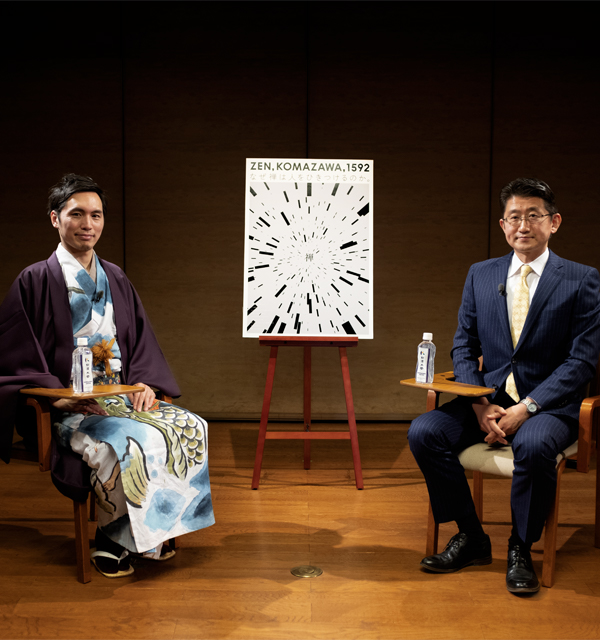
ZEN, KOMAZAWA, ART
For the third interview in the series, Mr. Satoshi Anzai of the Kyoto artistic unit Daruma Shoten and Prof. Tetsufumi Muramatsu of the Faculty of Buddhism of our university discussed the theme of “Zen and Art”.
Created after painstaking research and data collection and sometimes taking more than two years to complete one piece, Mr. Anzai’s artworks not only powerfully impact the eyes with their rich coloration but also enthrall the viewer with their meticulously woven “stories”.
To close the interview, 4th Year Faculty of Letters student Mr. Yoshii (a member of the K-JAZZ Society) played the saxophone as Mr. Anzai painted live in a special artistic collaboration.
※This interview was recorded on March 29, 2019 (Fri.)
Origins of Daruma Shoten
Muramatsu:It is an honor to meet you today, Mr. Anzai.
Anzai:Thank you very much. I have been looking forward to this.
Muramatsu:I am Prof. Tetsufumi Muramatsu of the Faculty of Buddhism. Thank you for speaking with me today.
Anzai:It's a pleasure to be here. I am Satoshi Anzai of Daruma Shoten.
Muramatsu:You introduced yourself as "Satoshi Anzai of Daruma Shoten", so that means Daruma Shoten is the professional name of your artistic unit, doesn't it?
How did the name Daruma Shoten originate?
Anzai:Daruma Shoten is a unit of two, me and my partner Shima. It's an artistic unit comprising two members.
Before Daruma Shoten was formed, there was a Dreams Come True concert at Naeba, the ski resort. So we were catching a train on the Takasaki line to go to this concert, and at the station they were selling boxed lunches called Daruma Bento. You may not have heard of it, but there's this boxed lunch that comes in a red container in the shape of a daruma doll. It was while we were eating out boxed lunches that we got talking and said, "Why don't we call ourselves Daruma Shoten?"
Muramatsu:So your unit name came from the name of a boxed lunch?
Anzai:That's right. I wanted to be able to say I studied at Komazawa University and we named ourselves after Zen Buddhist monk Daruma Taishi (Bodhidharma), but no, sorry, we named ourselves after a boxed lunch (laughs).
Muramatsu:But naturally, when people hear the name daruma, people immediately think of Zen Buddhism.
Anzai:This was 17 years ago, but when we were thinking about what unit name we should choose, we thought that daruma was an excellent choice because it's simple and easy to write and understand in Japanese hiragana script. Even now, lots of different people chant "Daruma-san, Daruma-san" at us like in the game Daruma-san Fell Over ("Statues"), so I think we chose a really good name.
Muramatsu:You are "Satoshi Anzai of Daruma Shoten", so as an artist, you're active in Kyoto, isn't that right?
Anzai:That's right. Currently we're in Kyoto. Originally I'm from Saitama Prefecture in the Kanto region, and I traveled to and from Komazawa University as a student from there. Daruma Shoten was formed in Tokyo. I wanted to learn about lots of things, such as ancient Japanese cultural aspects, including being involved with Buddhism, and I had wanted to draw these things for a long time. And so I thought, the place where such cultural aspects are still alive and well is Kyoto, of course, and sine my partner Shima is from the Kyoto region, we had no worries about going to live and study there. That's how I first came to Kyoto.
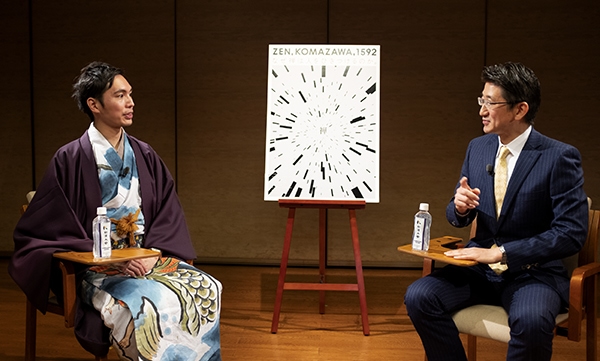
Muramatsu:I'm curious about what you're wearing. Should I say "costume"? You're wearing a kimono.
Anzai:That's right. Actually, I often wear kimono. Sometimes I include kimonos in my drawings, and since I feel that it is impossible for me to draw kimonos without familiarity with the real thing, I decided to actually wear kimonos and learned the correct way to wear them. I did some study so as to be able to infuse my artwork with reality, or tie it to a sense of reality, by experiencing for myself how kimonos are constructed and how people in the old days lived, and I became quite adept at wearing kimono.
Muramatsu:How admirable! What kinds of pictures do you usually draw, Mr. Anzai?
Anzai:I usually draw various different types of things. Creating artwork with computer graphics (CG) is a characteristic of our pictures. When people think of pictures, they probably image something a bit old, like using mineral pigments, but actually you could say I use the very latest artistic tools. Perhaps it's because I'm in Kyoto, but I use modern art tools to depict both Japan of the ancient past and Japan of today.
Muramatsu:Later you will be showing us your techniques, but is there anything that you pay particular attention to or take especial care with when you create your artworks?
Anzai:Well, when I am drawing a celebratory scene, I try to feel congratulatory while I am working. When I am drawing a serious or earnest scene, I do my research very carefully. If I don't do simulations and draw my pictures from the perspective of each subject, the pictures lose emotionality, and so I am a bit particular about that. Also, I also visit various different places and eat delicious foods or look at beautiful things in order to enhance my artwork.
Muramatsu:You seem to be creating art in the midst of everyday life.
Anzai:That's right. There are lots of things like that in Kyoto.
Muramatsu:There are also a lot of temples.
Welcome to Anzai world
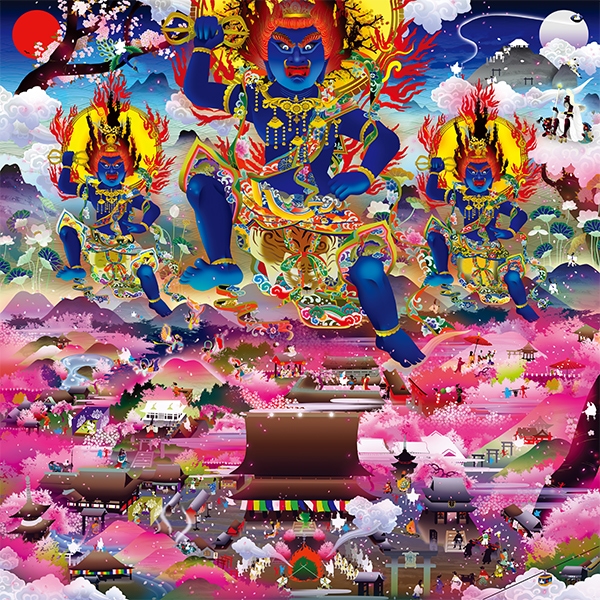
Gokusaishiki Yoshinogongen Sankei Mandara: The viewer's eyes are drawn to the bright blue of Zao Gongen (protective deity of the Shugendo sect) and the pink of the Yoshino cherry blossoms.
Muramatsu:I'd like to look at some of your pictures while we continue our chat.
This first picture that we're looking at is truly amazing. Right now it's the cherry blossom season in Japan, and this picture is filled with the lovely pink color of cherry blossoms. What does this picture depict?
Anzai:To explain it simply, the picture shows pink cherry blossoms and above them is the Buddhist deity Zao Gongen. In Nara Prefecture there is a mountain called Mt. Yoshino, and the cherry blossoms there are really gorgeous. It's such a famous sightseeing spot that it's been said since ancient times that Yoshino is THE place to see cherry blossoms. There is also a temple here called the Zao-do Hall, the Kinpusen-ji Temple (where the Zao-do Hall is located), and in the hall is an immense statue of the Buddhist deity Zao Gongen. The temple is surrounded by these mountains, and there is so much history. The picture is a sankei mandala (devotional picture of a temple landscape) that combines all these elements.
Muramatsu:Looking at the picture, it portrays Zao Gongen perfectly, doesn't it? The bright blue, the right leg raised, the right arm raised, the left foot stamping-—you surely must have gone and seen the stature before you drew the picture.
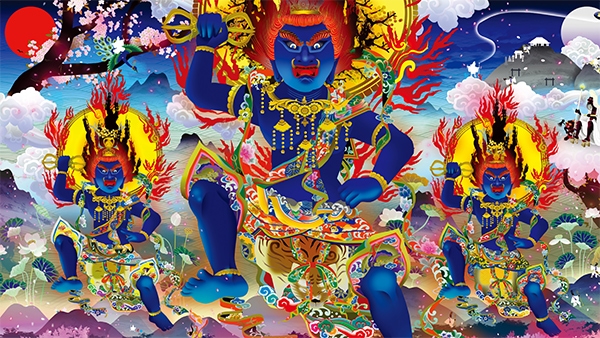
Anzai:Yes, I did in fact go and see the statue. It truly is a huge statue, and there's a small enclosure at the base for two people at a time to take a close look. Looking up from this enclosure, Zao Gongen looks down at you with a truly wrathful expression, he really is angry. In that moment I felt somewhat penitent , or rather sensed my own smallness, and so I wanted to express these feelings in the picture and also convey the loveliness of the cherry blossoms, which bloom truly beautifully at this time of year, in an easy to understand way.
Muramatsu:The picture draws the eyes with just a glance, and it's easy to understand, too.
Anzai:Thank you!
Muramatsu:I can see that it's Zao Gongen at a glance, but when I look at the picture more closely, I feel as if my eyes are drawn into the picture. One fascinating aspect of your picture is that it makes me feel as if being immersed further and further into the picture. Isn't this like Where's Wally? And I am tempted to look at the picture and even more of its fine details. Are there any particular highlights you recommend in your picture?
Anzai:There are various different historical events regarding Yoshino. I studied all of these, and I discovered various facts such as that Minamoto no Yoshitsune of The Tale of Heike fled to Yoshino, that Emperor Go-Daigo attempted to make Yoshino the capital city, and that Taiko Toyotomi Hideyoshi held tea ceremonies in Yoshino. I studied all this, and actually went to Yoshino and experienced the place for myself, and so I decided to infuse the picture with all the ages. It also includes aspects from the present time, such as people climbing the mountain.
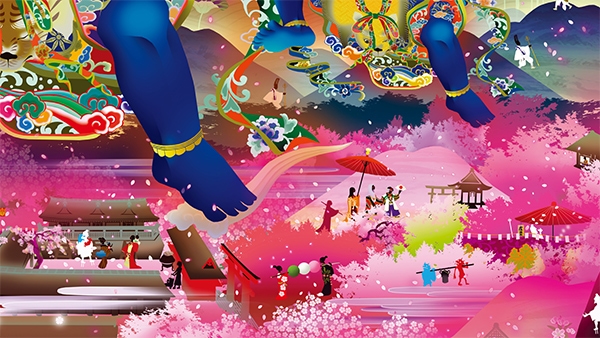
Muramatsu:The picture really draws me in. All right, then, let's look at the next picture, shall we?
Depiction of Hell that incorporates interesting historical elements

Gokusaishiki Takamurakyo Rokudoyuko Ezu: Beneath the 10 rulers of the afterlife spreads a hellish scene of the dead suffering in pain
Anzai:In Kyoto there is a temple called Rokudochinno-ji Temple, and this picture is dedicated to this temple. The picture was dedicated in 2011, and I don't know how the picture appears to you on first glance, but the blackish, slightly poisonous-looking area on the left represents Hell.
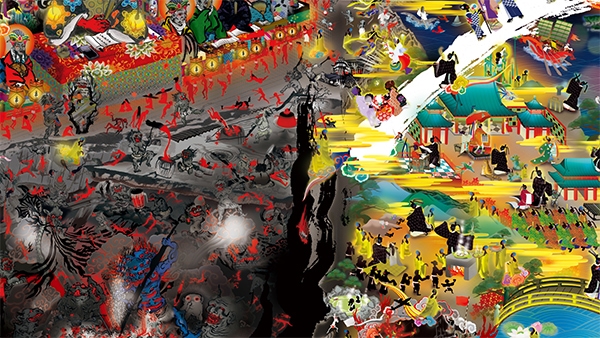
Anzai:The bright, slightly yellow area on the right is the Eastern Pure Land, which is different from Paradise, but the world of the Pure Land is a very beautiful place. The picture depicts a world in which the Healing Buddha exists, and the arch in the middle represents the world in which humans live. What I wanted to express through this picture was where people go, and where people want to go, between the time they are born and the time they die and then after they die?
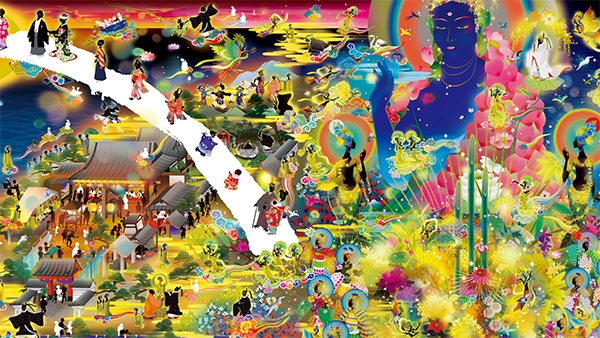
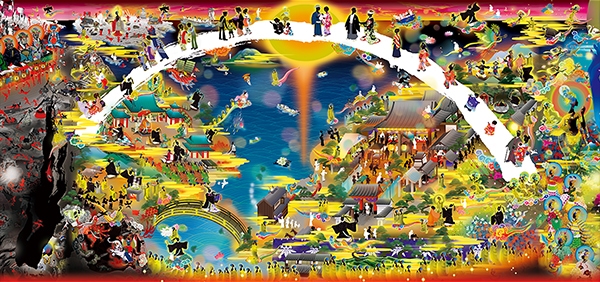
Muramatsu:The picture shows the Pure Land on the right, the present world in the middle, and Hell on the left. All right, then, let's look at Hell for a moment.
Anzai:This picture is also easy to understand, showing the Great King Yama surrounded by the other nine rulers and judges of the afterlife. The judges are judging the dead. Every seven days people who have died are judged on all the good things and the bad things that they did while they were alive.
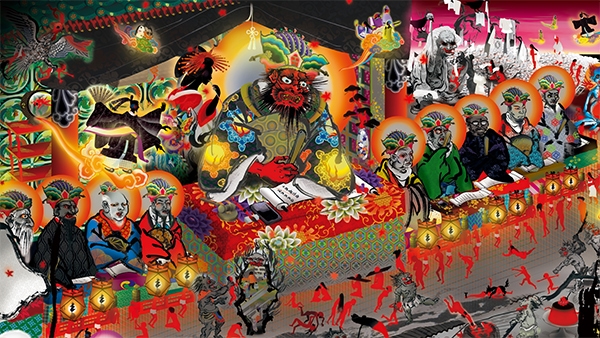
Muramatsu:Looking at the picture, it's very, very realistic—actually, it's really scary!
Anzai:The Rokudochinno-ji Temple has a well dating from ancient times that is said to go straight to Hell. According to legend, a Heian-period government official called Ono no Takamura would work as a public servant during the day and visit Hell during the night via this well , assisting the Great King Yama. It is said that he was like a secretary to Great King Yama. That's why I've depicted him here next to the Great King Yama and dressed in black Heian-period clothing, working away busily.
Muramatsu:Ono no Takamura appears somewhere in the picture?
Anzai:That's right. There are several people scattered here and there—can you see him? Near that black area...
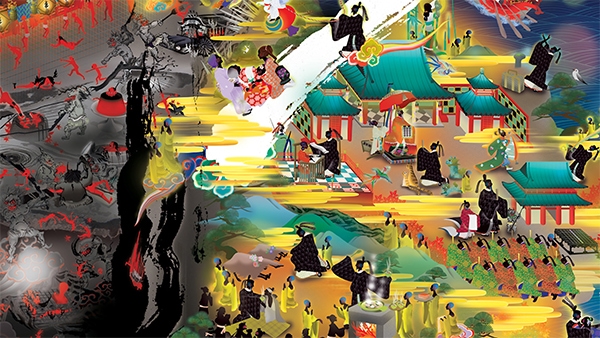
Anzai:Below that, the scenery suddenly descends into Hell.
Muramatsu:That's amazing!
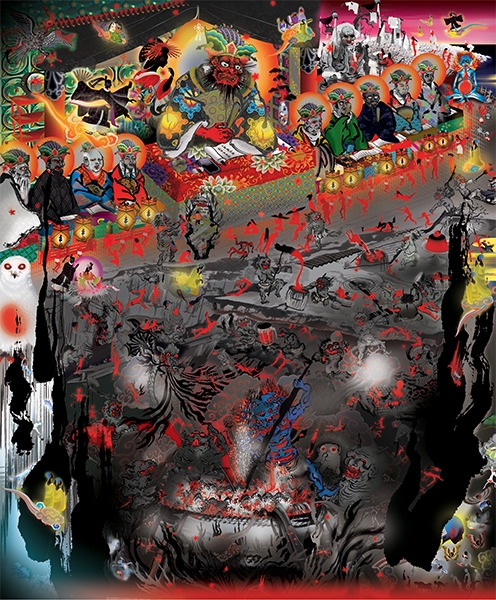
There's even a scene with some black humor where the human figures form the word "HELP!"
Anzai:Actually, a lot of traditional pictures of Hell are quite brutal, depicting demons cutting people up with carpenter's tools. These days you don't see carpenter's tools very often, do you? I do understand the pain aspect, though. In days gone by, these were familiar tools, and so people could imagine the pain when they looked at the pictures, so they say, "I definitely don't want to go there!" To make this picture look realistic to people living in modern times like us, to show that "This is a bit painful" my picture depicts people being tormented with modern kitchen equipment.
Muramatsu:Kitchen equipment?
Anzai:That's right, Around the center of the picture. There are people being juiced in juicers and other devices—people being turned into tomato juice (laughs). Also, you've seen an egg slicer, haven't you? There's a large version of one of these in the picture, slicing up people. The scenes are enough to give you goosebumps a bit...
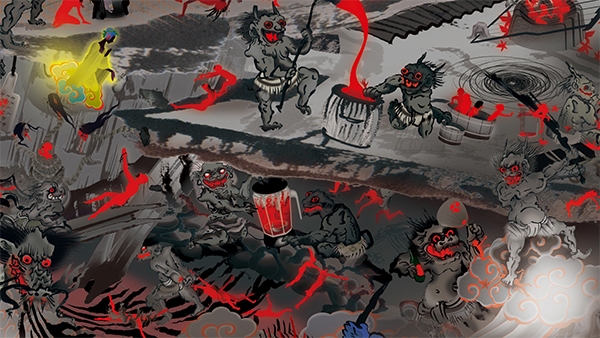
Muramatsu:They definitely give me goosebumps! At home, I've grated my finger when grating radish.
Anzai:That must have hurt.
Muramatsu:I really cut myself badly…These devices really do make you want to absolutely avoid going to Hell, don't they?
Anzai:I've also including radish-grating in the picture—red grated radish (laughs)
Muramatsu:And this is where Ono no Takamura appears?
Anzai:Yes, he's a bit higher on the left....Ono no Takamura is next to the woman in the pink kimono, wearing black clothing. There's a bit of an atmosphere of the woman asking him for lenience. Why is there a woman in Hell? Well, in fact there are many different hells within Hell itself. There are people in Hell for various crimes, like murder and so forth, but people have also gone to hell for adultery and playing around with the ladies.
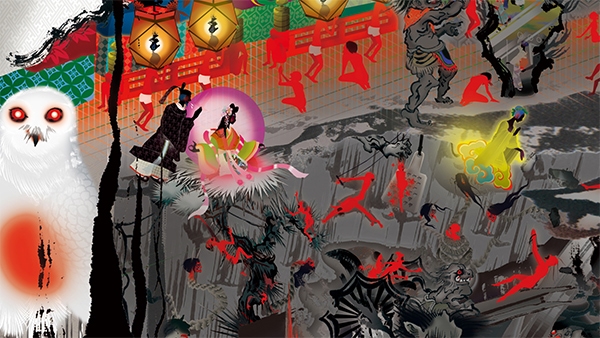
Muramatsu:It's frightening.
Anzai:Yes it is. You should be careful, too! (Laughs)
Muramatsu:I most certainly will be careful.
Anzai:Also, in Hell there is a pine tree with leaves in the shape of nails, and there's a beautiful girl sitting in this tree. When she calls out, "Come here, come here!" the dead men want to go to her, so they climb the tree.
Muramatsu:That seems normal.
Anzai:Since the leaves are all barbs, the men get stabbed as they climb. And when they get to the top of the tree, the beautiful girl isn't there, she's at the base of the tree. Now she calls to the men from the base of the tree, "Come here, come here!" And the leaves are pointing upwards, so they pierce the men as they climb down....There is a hell where this is repeated over and over for eternity. I though, if I didn't draw this particular scene, men wouldn't get it.
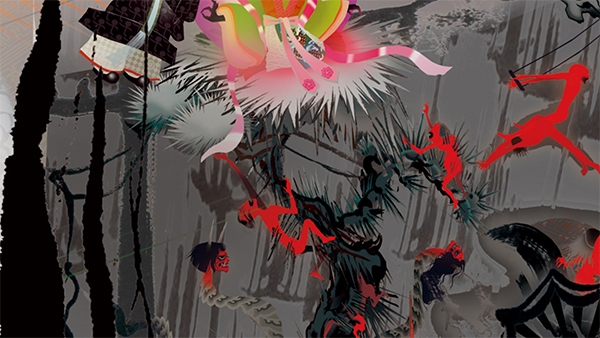
Muramatsu:No one seeing this would ever commit adultery.
Anzai:This form of punishment is the same today as it was in ancient times.
Muramatsu:But really, the girl truly is beautiful, isn't she?
Anzai:She is, isn't she? Usually the beautiful girls depicted in pictures of Hell are fictitious, but for this picture I decided to draw a relative of Ono no Takamura, so the beautiful girl is a woman called Ono no Komati.
Muramatsu:Inserting historical facts into the picture like that is very interesting. However, just looking at picture of Hell is a bit depressing, so shall we move onto the next picture?
Instagrammable fusuma (sliding door) picture that took two years to design
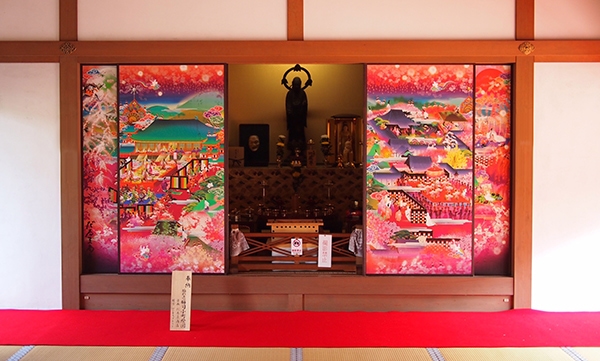
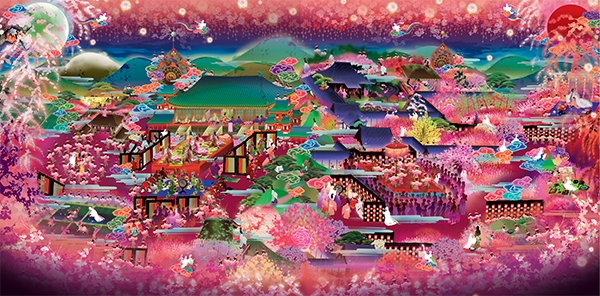
Gokusaishiki Umeiro Komachi Ezu: A gorgeous depiction of the life of Ono no Komachi
Anzai:OK, then. This is a fusuma (sliding door) picture that I dedicated to the Zuishin-in Temple in the Yamashina area of Kyoto. The trendy word "instagrammable" may suit this picture perfectly because of its truly feminine and gorgeous aspects, that's the kind of sliding door it turned out to be. The temple has connections with Ono no Komachi, whom I just mentioned.
Muramatsu:So does the picture also include Ono no Komachi?
Anzai:Yes, it does. The Zuishin-in Temple stands in the place where Ono no Komachi is said to have spent her final years. This sliding screen depicts the life of Ono no Komachi, that's the reason I created the picture.
Muramatsu:It depicts her entire life, from when she was born until she died?
Anzai:That's right. Ono no Komachi was born and became the emperor's consort, but after he died she spent her final years in the area of Yamashina where the Zuishin-in Temple now stands. She was extremely beautiful, and so many men flirted with her, but she turned them all down. ..Ultimately she died alone, so the story has a bit of a sad ending.
Muramatsu:The picture shows scenes from her life from left to right, I see.
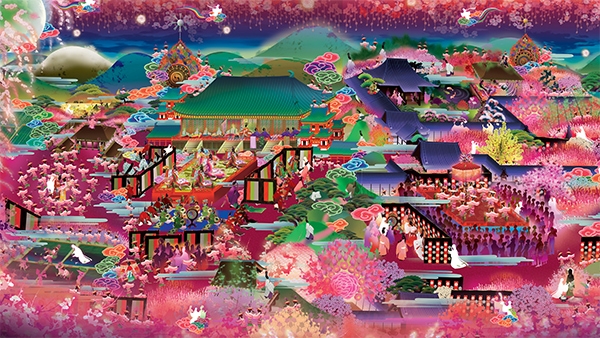
Anzai:Yes, it shows her entire life.
Muramatsu:This is another beautiful picture that draws my eyes into it, but was there anything that you were especially particular about when you were creating it?
Anzai:I'm sure most people have never seen a pink-colored sliding screen. Actually, saying "pink" makes it sound a bit modern; in Heian Japan, this color was known as hanezu-iro.
Muramatsu:Hanezu-iro.
Anzai:Yes. What we would call "reddish brown" today was known as hanezu-iro in Heian times. This temple has a plum orchard, and the color of the orchard's plum blossoms is hanezu-iro. Normally you would say that plum blossoms are white or red. Hanezu-iro is a dignified expression, and these plum blossoms are gorgeous double-flowered blossoms like peonies, and I think they should be coming into bloom just about now.
Muramatsu:Did you actually go to see the plum blossoms and then recreate their color?
Anzai:That's right, I did. In the picture I wanted to link expression of the temple's notable characteristics with the fact that Ono no Komachi, a woman who was once exceptionally beautifully, had lived here.
Muramatsu:How many figures of Ono no Komachi have you drawn in the picture?
Anzai:In depicting her entire life beginning from when she was born, there is a scene where Ono no Komachi is floating along on fluffy white clouds. I call this depiction the "Ghost Komachi".

Muramatsu:"Ghost Komachi"?
Anzai:That's right. Komachi herself is remembering her life after she has died. She's thinking, "I was loved by such a variety of people, there were many happy times, and my life was satisfying." She's remembering back over her life, thinking, "I may have become an old woman, but my life was truly rich and I was loved by many people, it was a good life." Not even figures depicted in ancient sankei mandala (devotional picture of a temple landscape) are this perfectly white, but there are ancient paintings that have survived to the present day that depict people dressed all in white walking steadily along. These are actually dead people who are visiting various temples before ultimately going to heaven. This is the story I based the picture on, and the figure of Komachi is pure while to make the story easy to understand.
Muramatsu:So, the picture shows Ono no Komachi's life, and then Komachi herself is looking back over her life after she has died, saying, "Oh, what a good life I had."
Anzai:Ono no Komachi was a great beauty of the Heian period, and so although the picture depicts the Heian period, it also incorporates elements from modern times. There is a festival being celebrated at a modern-day temple, and the people watching the festival are modern-day people. It may be a bit difficult to see this from the silhouettes, but the spectators are holding up mobile telephones and cameras and photographing or filming the festival.
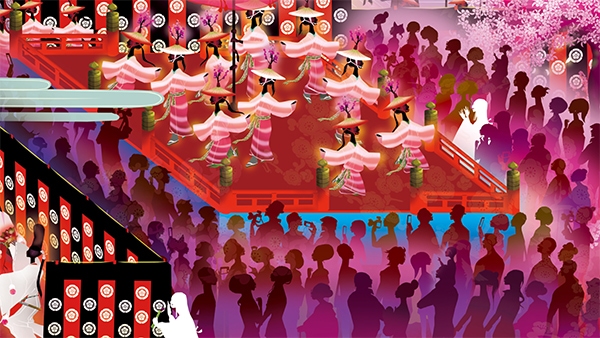
Muramatsu:The people watching Ono no Komachi have mobile telephones or cameras?
Anzai:This phenomena of everyone taking pictures like this, it's an aspect of today's culture, isn't it? This did not happen in the past. However, I thought it actually wouldn't be out of place in that scene, and so that's why I drew in the gadgets. So when someone looks at the picture in 100 years or so, from now, they may wonder, "What are these people doing?" I hoped to be able to express that this is the Heisei generation, and this is a culture where people carry around cameras and take photographs.
Muramatsu:You travel back and forth in time and space.
Anzai:Yes.
Muramatsu:Incidentally, how many months did it take you to create this picture?
Anzai:I spent more than two years conceptualizing the picture, and then actually drawing it took me three months.
Muramatsu:Drawing it took three months? Conceptualizing it took two years?
Anzai:That's right. I had to research everything, all the history and whatever, from scratch, and so my partner also shared the work and we created the picture together.
Muramatsu:You really do a lot of preparation, a lot of research, before you draw a picture, don't you?
Modern-day Kyoto paradise depicted in tens of thousands of colors
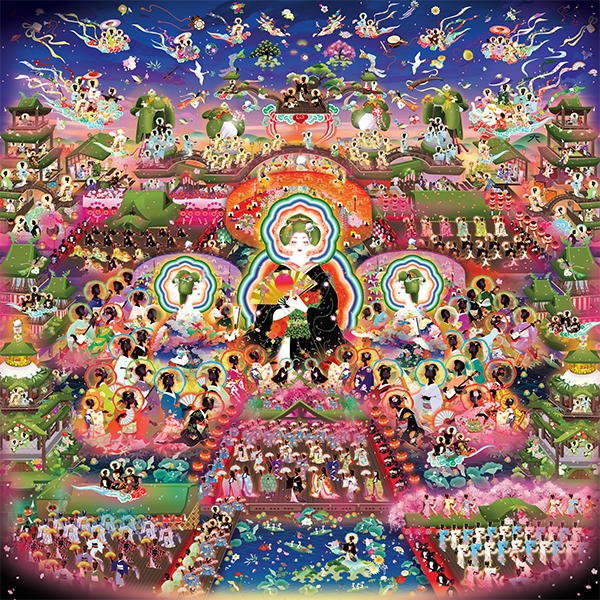
Gokusaishiki Hyakumaiko Okoshiyasu Ezu: Depiction of modern-day Kyoto based on the Taima Mandala
Anzai:At the Taima-ji Temple in Nara Prefecture, there is a large picture depicting the paradise of the Amida Buddha, known as the Taima Mandala. This picture completely follows the form of the Taima Mandala, or rather, it is based on the Taima Mandala with all the worshippers of the Amida Buddha who have reached enlightenment portrayed as Kyoto Maiko or Geiko entertainers. So this is the paradise of modern Kyoto.
Muramatsu:Paradise, that's right. Conventionally this scene is depicted with beings who have attained enlightenment, bodhisattva, and dancing angels, but in this picture, if you look closely you can see that everyone is female.
Anzai:That's right, everyone is female.
Muramatsu:Even the central figure.
Anzai:Yes, even the central figure. I created this picture after wondering what it would be like to depict a Buddhist paradise that fully utilizes the beauty of Kyoto that we ourselves have tasted, the beauty of Kyoto's Maiko ands Geiko entertainers.
Muramatsu:In order to draw Maiko and Geiko, surely you would have had to do quite a lot of preparation and groundwork?
Anzai:In Kyoto there are currently five Geisha districts, knows as the Gokagai. These districts include Gion as well as Miyagawa-cho and Kamishichiken, and they all have beautiful Maiko and Geiko, but each has their own style of dance. In the current spring season, there is an event called the "Spring Dance" where all the entertainers dance on stage, and this event appears in the picture. Also, since there are many opportunities in everyday life for us to get to know Maiko and Geiko, I actually asked them to show me their kimonos and how they put on their kimonos, and I have incorporated this authentic beauty into the picture.
Muramatsu:Conventionally the central figure would be the Amida Buddha, but in this picture there are Geiko and Maiko instead. Aren't the kimonos they're wearing, for example, really authentic?
Anzai:Yes they are. I drew the Maiko wearing kuro montsuki (black crested kimono). The Maiko are wearing kimonos dyed with simple plant designs. Flowers and the like. The kimonos are not dyed with any especially ostentatious designs, not many animals. Maybe butterflies, or other pretty patterns. And I thought, "Wouldn't it be wonderful if these flowers were brought to life in paradise in the form of Maiko?" And this is how the picture turned out.
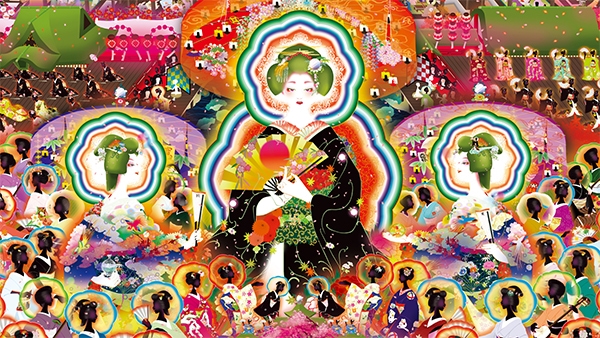
Muramatsu:The kimonos are lovely, but the hairstyles are very ornate.
Anzai:I have been interested in traditional Japanese hairstyles since my student days. I don't think there are many opportunities for people to see such hairstyles nowadays. Actually, when I was a student I only ever saw these hairstyles in materials, not in real life, and I thought that there were no actual people who wore them today. I thought they'd become obsolete after the Edo period ended. But when I went to Kyoto, I discovered that Maiko as a rule coiffure their own hair, they don't wear wigs. The culture of Maiko growing their hair very long and coiffuring it is a cultural tradition that has continued over centuries to the present day.
Muramatsu:So, did you go to see Maiko actually coiffuring their hair?
Anzai:There is actually a hair stylist, known as kamiyui, who coiffures the entertainers' hair. Not a specialist hairdresser. I actually watched and studied various kinds of traditional Japanese hairstyles being coiffured, and this led me to drawing many pictures with traditional Japanese motifs. Women in bygone eras, their hairstyles differ from period to period. I developed a desire to actually coiffure such hairstyles myself, and so I asked a hairdresser to buy a mannequin for me and I actually created hairstyles using the mannequin and I incorporated these into designs for drawing my artwork.
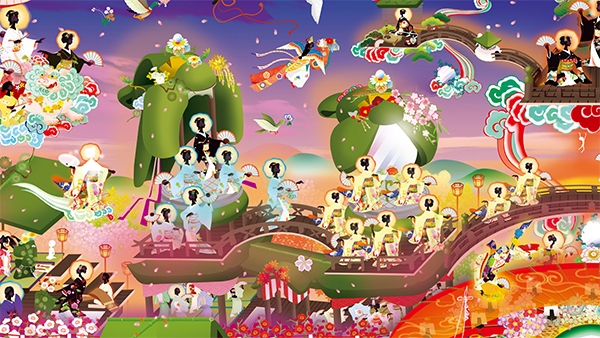
Muramatsu:You actually styled a Maiko's hairstyle yourself on a mannequin?
Anzai:I did.
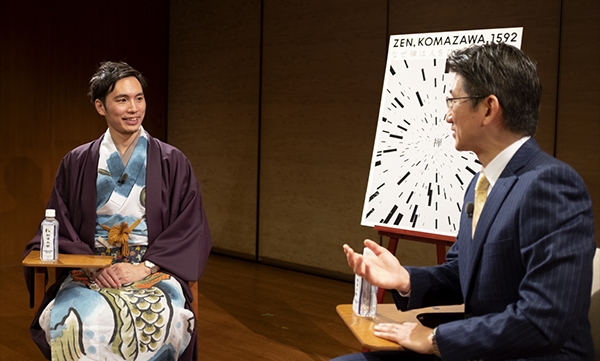
Muramatsu:Are there any other highlights to this picture you could tell me about?
Anzai:In the actual Taima Mandala, a really comfortable space is depicted, with musical instruments floating about freely and making music. It depicts instruments such as the biwa of that era, various instruments of that era, floating about. My picture depicts the world of Maiko and Geiko, and so I incorporated various traditional Japanese instruments such as the shamisen, bells, and drums.
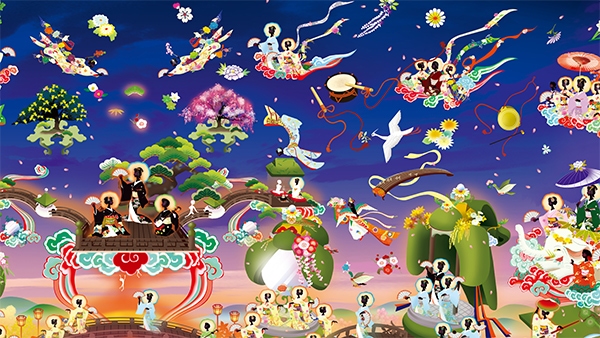
Muramatsu:Certainly, the original Taima Mandala also has musical instruments dancing about in the sky and playing music, and so what you did is show modern-style instruments that Maiko and Geiko use floating about. Your picture certainly holds its own against the original Taima Mandala.
Anzai:I learned that gokusaishiki (rich coloration) is a word that is frequently mentioned in Buddhism, but these days people don't use the term very often. Instead we say iroazayaka or "colorful", but since ancient times temples have been gokusaishiki spaces. Inside the Phoenix Hall of Byodoin Temple in Uji, for example. "Paradise" is a "world filled with color" and this is also reflected in this picture through the colors and beauty of the entertainers' kimonos.
Muramatsu:The picture is very colorful; around how many kinds of colors did you use?
Anzai:That's a good question. Probably several tens of thousands of colors.
Muramatsu:Several tens of thousands?!
Anzai:That's right. It is possible to recreate that number of colors and shades when you use a computer.
Muramatsu:The pond in front of the central figure—the Pure Land pond is a lotus pond, and so naturally you have also drawn a lotus pond in your picture, but are those people in the pond?
Anzai:Yes.
Muramatsu:The white-colored humans in the pond, what's their significance?
Anzai:In the original Taima Mandala, when the people who have died come to the Pure land, they say, "I have been reborn and come to this world", but in our picture, the dead have slightly large heads, and everyone tells us that they look like aliens from outer space.
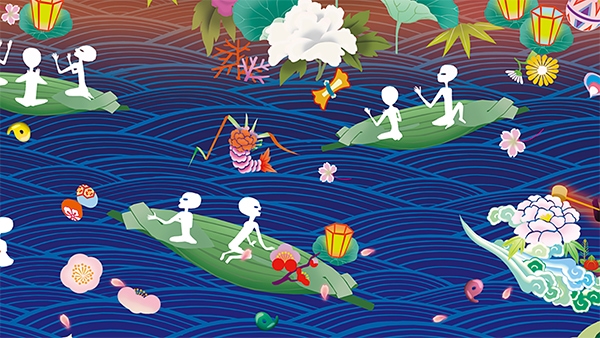
Muramatsu:Aliens?
Anzai:Actually, I've been drawing many pictures with alien motifs since my student days.
I'm not sure that inserting aliens from outer space into Buddhist mandalas with somewhat heavy themes is something I really should be doing, but I see the aliens as myself.
Muramatsu:You are an alien?
Anzai:The reason for this is that I've been living in Kyoto now for 15 to 17 years or so. I've met many people through the Geisha districts and Buddhism and temples, etc., and I've been to various places with deep significance, but in reality I cannot become a Kyoto-ite, and I cannot become a Buddhist monk, either. I can only look into these worlds. Maybe not stepping back and taking a wider perspective, but I think that the aliens symbolize my existence in Kyoto. You could say I'm having fun within the world of the picture.
Muramatsu:Looking at your pictures, Mr. Anzai, there's the fun aspect of wondering whether or not you'll encounter an alien.
Anzai:I think that people searching for aliens in the pictures is one way for people to enjoy them. Pictures must be enjoyed. It's fine for people to take a glance and immediately think, "Oh, that's pretty" or have an emotional response, but I think people can also enjoy the pictures by looking at the details and discovering things—a bit like a treasure hunt.
Muramatsu:You are completely right. The enjoyment of looking at a picture. Viewers must enjoy the picture. Discovering for yourself what the artist wants to convey is certainly one way to enjoy a picture. In your case, Mr. Anzai, the "aliens" are an important point.
Anzai:Also, I think it would be wonderful if people visited Kyoto after seeing this picture. I think it would also be interesting if people were inspired by the picture to go and see the real thing in person. I learned that ancient sankei mandala (devotional picture of a temple landscape) were spread throughout Japan by a Buddhist nun called Kumano no Bikuni, who proclaimed to everyone she met that "Kumano is this beautiful place!" She carried around sankei mandala in the way we carry around guide maps nowadays, explaining the pictures to people as she travelled around the country . So I think it would be wonderful if people decided to come and see Kyoto, or became interested in Japanese culture or Buddhist artwork as the result of seeing this picture.
Muramatsu:In the past there was a practice known as etoki whereby people were shown pictures while priests or nuns explained about Hell and Paradise. When you are drawing your pictures, Mr. Anzai, do you also have an image of etoki in your mind as you draw?
Anzai:Well, when I am actually there I'll explain the meaning, and when I'm not there, I'll leave the pictures to convey their meaning for themselves as far as possible. I would be happy if viewers felt various emotions as they looked at the pictures, such as "That's pretty!" or "That's scary".
Continuing to draw with a spirit of ninnun toto
Muramatsu:We've looked at some of your wonderful pictures, Mr. Anzai, but when you are drawing these lovely artworks, is there a word or phrase that you have as your personnel motto?
Anzai:There are lots of words and phrases that I like, but at the moment a favorite phrase, or a phase I take care to implement in my work, is ninnun toto. Ninnun is a combination of kanji characters that means "leaving matters to fate", while toto uses one of the kanji characters in the Japanese word meaning "boil", so the word expresses a wellspring bubbling with emotions. When I am actually drawing my pictures, the ideas bubble up in my mind like spring water. "Oh, I'll draw it like this," or "I'll use these ideas and combine them in this way. If I don't write down these ideas, I forget them, and so the repetition of this process leads to the creation of one finely detailed picture. The phrase ninnun toto expresses my desire to continue creating my pictures exactly as I want to without becoming exhausted.
Muramatsu:So you are thinking as you draw.
Anzai:That's right.
Muramatsu:The phrase ninnun toto is a saying of Daruma Taishi (Bodhidharma), isn't it? So you are creating these wonderful pictures with a Zen spirit!
Anzai:Yes, thank you.
Muramatsu:That's incredible. Every time I look at one of your pictures in the future, Mr. Anzai, I will remember the phrase ninnun toto and think, "Mr. Anzai is enjoying himself as he creates his pictures."
Thank you very much for speaking with me today.
Anzai:Thank you.
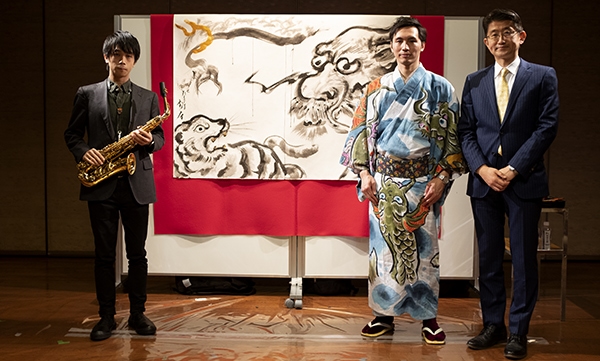
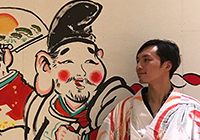 Satoshi Anzai
Satoshi Anzai
Born in Saitama Prefecture in 1981, Satoshi Anzai graduated from the Department of Japanese Literature, Faculty of Letters, Komazawa University. He taught himself to draw and paint as a child, and after graduating from university he formed the artistic unit Daruma Shoten and relocated to Kyoto. Specializing in dynamic brushwork and multicolored, subtle graduations, he uses a variety of artistic media ranging from ink to computer graphics. ANZAI’s representative works are also diverse and include such artistic pieces as sliding screen paintings at Daihonzan Zuishin-in Temple (Zentsu-ji branch of the Shingon sect of Buddhism); folding screens at Rokudo Chinno-ji Temple, a sub-temple of Daihonzan Kennin-ji Temple (Kennin-ji branch of the Rinzai sect of Buddhism); posters for famous entertainer management company Yoshimoto Kogyo; packaging for long-established Japanese confectionary; and pictures and paintings for festivals held around Japan. His artwork has also been exhibited in France and Vietnam.
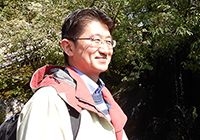 Tetsufumi Muramatsu
Tetsufumi Muramatsu
Born in Tokyo in 1967, Tetsufumi Muramatsu completed a doctoral program at the Graduate School of Letters, Arts and Sciences, Waseda University, without receiving a doctoral degree. After working at the Waseda Aizu Museum, he came to the Faculty of Buddhism, Komazawa University. Professor MURAMATSU also teaches at Nikkei Culture Inc., Tokyo Seminar BE, and the Waseda University Extension Center. His field of specialization is Buddhist art history. His major works include Kawaii, Kirei, Kakkoi, Tanoshii Butsuzo no Mikata (Cute, Pretty, Cool, Fun—How to Look at Buddhism Images) (BUNGEISHA Co., Ltd.) and Sugu Wakari Toyo no Bijutsu (Easy-to-understand Oriental Art) (TOKYO BIJUTSU Co., Ltd.)
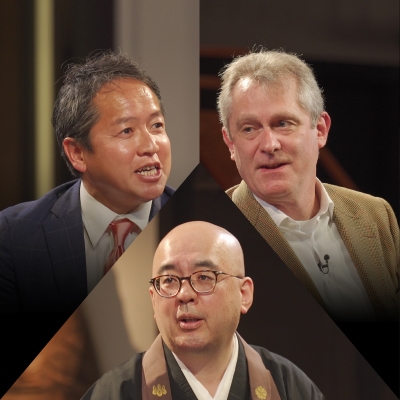
SPECIAL
ZEN,KOMAZAWA,MANAGEMENT
For our 5th discussion in this series we welcomed guest participant Mr. David Atkinson, CEO of Konishi Decorative Arts and Crafts, for a three-way dis・・・
2020.08.07
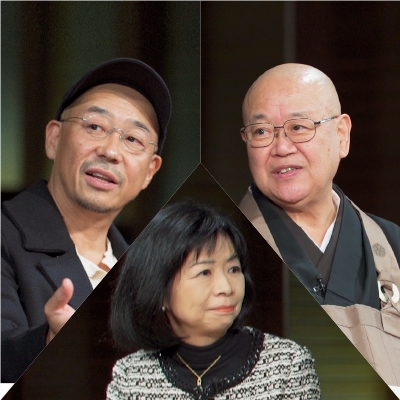
SPECIAL
ZEN,KOMAZAWA,MOVIE
For our fourth interview we welcomed film director Tatsushi Ōmori as our guest, and together with Komazawa University Chancellor Seishi Nagai and Prof・・・
2020.03.05

